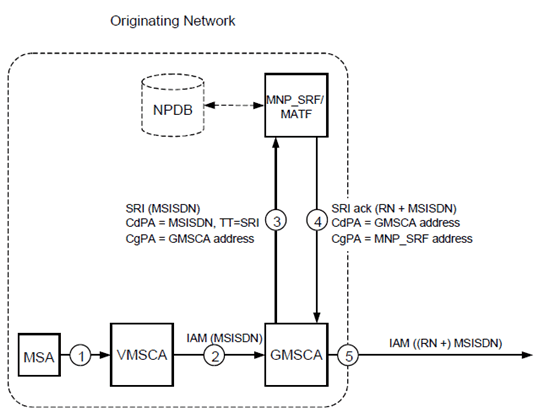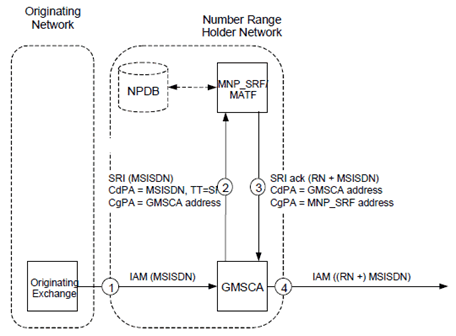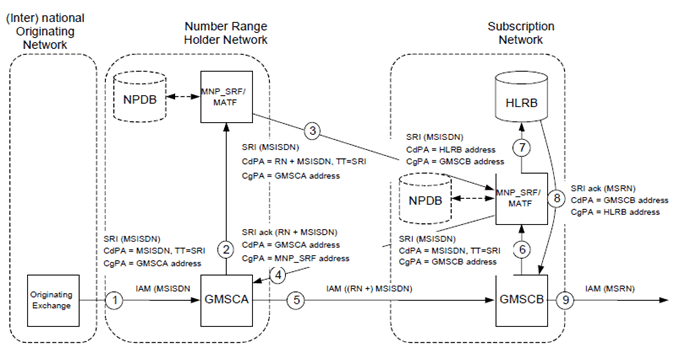Content for TS 23.066 Word version: 18.0.0
C.3.3 Mobile Originated Call to a Ported or not known to be Ported Number - Originating Network ≠ Subscription Network- Direct Routeing
C.3.4 Call to a Ported Number - Indirect Routeing
C.3.5 Call to a Ported Number - Indirect Routeing with Reference to Subscription Network
...
...
C.3.3 Mobile Originated Call to a Ported or not known to be Ported Number - Originating Network ≠ Subscription Network- Direct Routeing p. 69
Figure C.3.3 shows the signalling involved for a national mobile originated call to a number not Subscribed in the originating network via direct routeing. The scenario describes signalling in the originating network using direct routeing in the cases when an own number is ported out, a foreign number is not known to be ported or a foreign number is ported to other foreign network.

Figure C.3.3: National mobile originated call to a ported number via direct routeing
(⇒ copy of original 3GPP image)
(⇒ copy of original 3GPP image)
- MSA originates a call to MSISDN.
- VMSCA routes the call to the network's GMSCA.
- When GMSCA receives the ISUP IAM, it requests routeing information by submitting a MAP SRI to the MNP_SRF/MATF. The TT on SCCP may be set to 'SRI'.
- When the MNP_SRF/MATF receives the message, it analyses the MSISDN in the CdPA and identifies the MSISDN as not known to be ported or being ported to another network. As the message is a SRI message, the MNP_SRF/MATF responds to the GMSCA by sending an SRI ack with a RN + MSISDN; For the case the number is not known to be ported the routeing number may be omitted.
- GMSCA uses the (RN +) MSISDN to route the call to GMSCB in the subscription network. Depending on the interconnect agreement, the RN will be added in the IAM or not.
C.3.4 Call to a Ported Number - Indirect Routeing p. 70
Figure C.3.4 shows the signalling involved for a call to a ported number via indirect routeing.

- From an Originating Exchange a call is set up to MSISDN. The call is routed to the number range holder network.
- When GMSCA in the number range holder network receives the ISUP IAM, it requests routeing information by submitting a MAP SRI to MNP_SRF/MATF. The TT on SCCP may be set to 'SRI'.
- When the MNP_SRF/MATF receives the message, it analyses the MSISDN in the CdPA and identifies the MSISDN as being ported to another network. As the message is an SRI message, the MNP_SRF/MATF responds to the GMSCA by sending an SRI ack with a RN + MSISDN.
- GMSCA uses the RN + MSISDN to route the call to GMSCB in the subscription network. Depending on the interconnect agreement, the RN will be added in the IAM or not.
C.3.5 Call to a Ported Number - Indirect Routeing with Reference to Subscription Network p. 71
Figure C.3.5 shows the signalling involved for a call to a ported number where indirect routeing with reference to the subscription network is used.

Figure C.3.5: National or international originated call to a ported number where indirect routeing with reference to the subscription network is used
(⇒ copy of original 3GPP image)
(⇒ copy of original 3GPP image)
- From an Originating Exchange a call is set up to MSISDN. The call is routed to the number range holder network.
- When GMSCA in the number range holder network receives the ISUP IAM, it requests routeing information by submitting a MAP SRI to the MNP_SRF/MATF. The TT on SCCP may be set to 'SRI'.
- When MNP_SRF/MATF receives the message, MNP_SRF/MATF operation is triggered. The MNP_SRF/MATF functionality analyses the MSISDN in the CdPA and identifies the MSISDN as being ported to another network. As the message is a SRI message, the MNP_SRF/MATF function relays the message to the subscription network by adding a routeing number to the CdPA which information may be retrieved from a database. After modifying the CdPA, the message is routed to the subscription network.
- When MNP_SRF/MATF in the subscription network receives the SRI, it responds to the GMSCA in the number range holder network by sending a SRI ack with a RN + MSISDN.
- GMSCA uses the (RN +) MSISDN to route the call to GMSCB in the subscription network; Depending on the interconnect agreement, the RN will be added in the IAM or not.
- When GMSCB in the subscription network receives the ISUP IAM, it requests routeing information by submitting a MAP SRI to MNP_SRF/MATF. The TT on SCCP may be set to 'SRI'.
- When MNP_SRF/MATF receives the message, MNP_SRF/MATF operation is triggered. The MNP_SRF/MATF functionality analyses the MSISDN in the CdPA and identifies the MSISDN as being ported into the network. The MNP_SRF/MATF function then replaces the CdPA by an HLRB address which information may be retrieved from a database. After modifying the CdPA, the message is routed to HLRB.
- When HLRB receives the SRI, it responds to the GMSCB by sending an SRI ack with an MSRN that identifies the MSB in the VMSCB.
- GMSCB uses the MSRN to route the call to VMSCB.